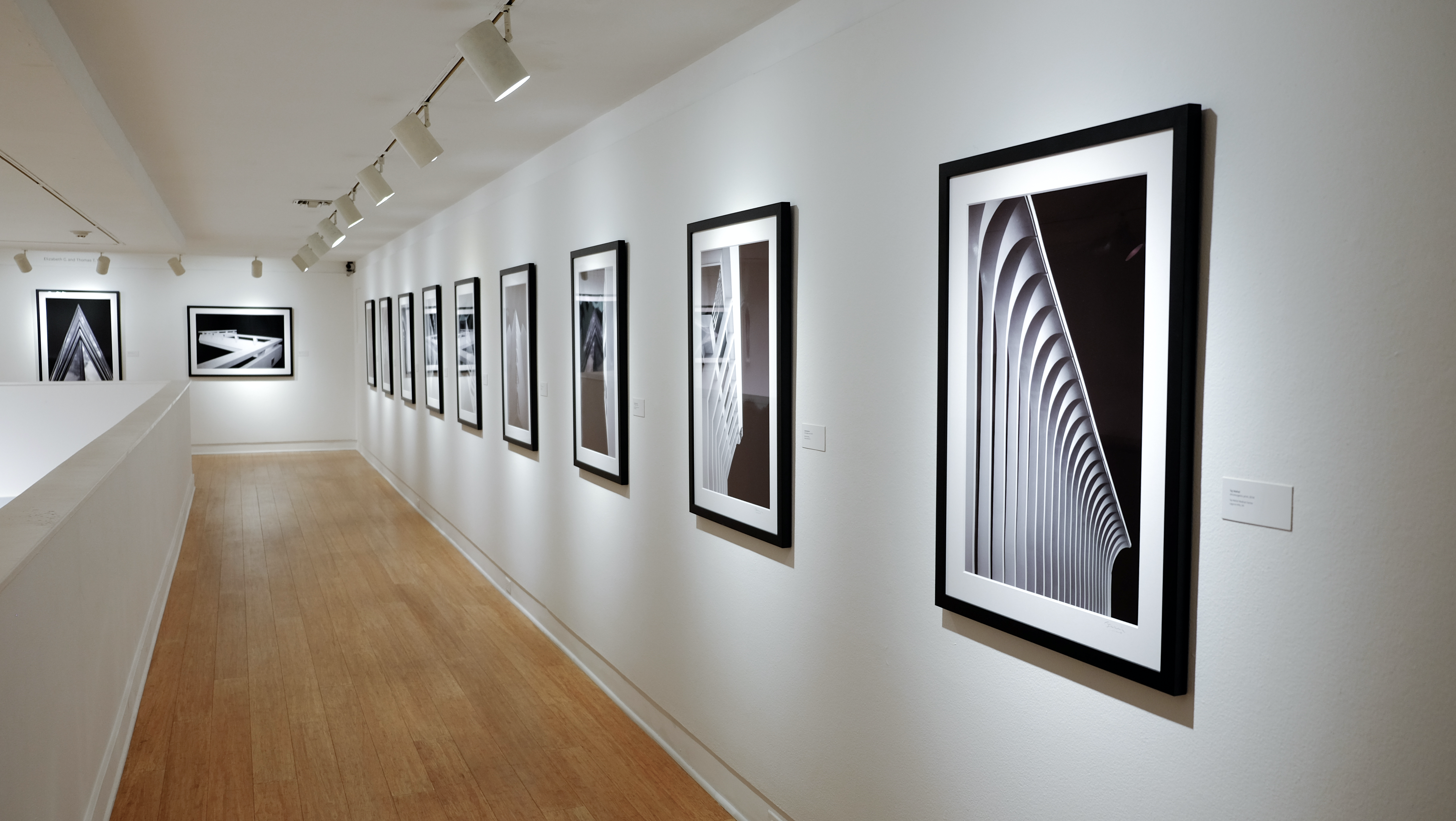
13 Aug Artist to Artist: In Gallery conversation with Jacques Garnier
When I first started taking art seriously and began to learn how to paint, I heretically thought of photography simply as source material for paintings. I tried making figurative paintings based off the work of Herb Ritts, Imogen Cunningham, and others. All those years ago I could not have appreciated the depth and complexity of the relationship between photography and painting that Jacques Garnier has presented in his latest exhibition Hymns to The Silence.
On display at Laguna Art Museum since this past Spring, I’ve walked through it many times. I can’t help being drawn into the haunting nature of the work. The eerie recognizability of building fragments with an abundance of detail placed up against a solid black void makes it impossible for me to deny the strong feelings that are stirred. Pieces such as “Adrift” give me an instant feeling of anxiety as I imagine falling over that ledge into the infinity of the black void. I know Jacques wouldn’t agree that anxiety is the subject of the work, but a multiplicity of meaning wouldn’t exactly be met with disapproval either.

Jacques Garnier granted me the privilege of a personal walk-through of the exhibition. Our discussion ranged from the subjects of repetition, Wabi Sabi, and the idea of slowing down which is inherent in Jacques’ work. We started off talking about the dangers presented by falling into a repetitious state of mind.
Jacques Garnier: “It’s harder and harder to find interesting angles and things without repeating yourself. That’s a really big issue for me. It’s too easy to do the same thing over and over, especially if you have a successful piece. You kind of fall into the same mode, and that’s really a slippery slope to go down.”
I can understand the need to break out of that repetitious state of mind an artist can slip into. We never want to feel like we’re spinning our wheels and re-treading the beaten path. Though, repetition can help an artist notice the minute differences between the works in a series, and come to the realization that the work isn’t quite the same as you think it might be. So, there are dangers as well as benefits. As Jacques and I talked about this further, I started to wonder what he considers the difference between being repetitive and working with a series.
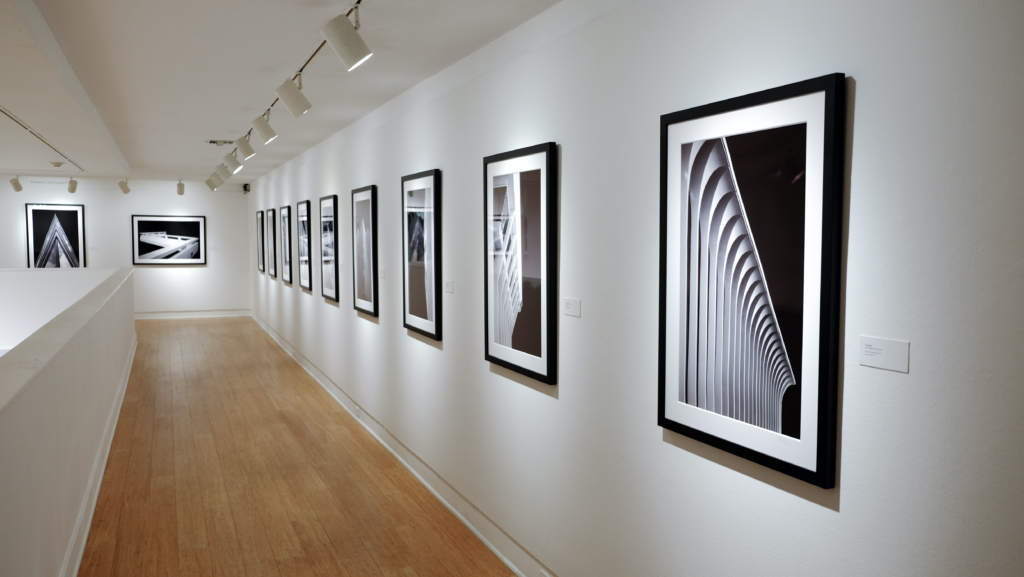
JG: “I’ve usually worked on a series anywhere from two to four years, and there seems to come a point where you go ‘you know what, I think that’s it. I think I’ve written the last chapter.’ It’s not necessarily thought out, it’s just all of a sudden, you know, ‘Hey, I’m trying to milk a cow man and this cow just doesn’t have any milk anymore!’ Then I go into a funk and a hiatus.”
I was surprised to hear him admit so easily something that you might not ever hear other artists say. To admit that you’re in a funk is to confront your own creative bankruptcy. Something that I’m always afraid of and always try to keep at bay. Jacques is a very articulate, focused, and experienced artist who knows the rhythms and idiosyncrasies of his working process very well. So, I shouldn’t be surprised that he knows how to prepare for those down times.
JG: “What I’ve done when I’m finished with a series is try to break the mold. I want to do something very different; stylistically, thematically, intellectually. Whether I succeed or not, I don’t know. I’m usually in a funk for 6 months to a year where I just can’t seem to mine anything creative at all.”
I had to ask Jacques about how bad those funks have been. Has he ever hit “rock bottom” with them? Has his confidence as an artist ever been shaken to the core?
JG: “My confidence certainly has been shaken, but I always eventually come out of it, so that inspires me to continue. There are certainly some tricks I use to try to get myself motivated again. One of them is to just go out randomly shooting. Often, I will use a lens that I have not used in a while, so that my view of the world will have to change. Then I go out shooting with no particular direction or motive in mind, but just trying to allow myself to be open to whatever is suggested to me. So, to answer your question directly, my confidence has certainly been shaken, but I always bounce back – or at least I have so far.”
So, the lesson here is to keep working. No matter how creatively bankrupt you think you are as an artist, staying busy and productive will always lead you out of it. As Picasso once said, “Inspiration does exist, but it must find you working”.
It was during one of Jacques’ “funk” periods that he threw himself into a search for a deeper understanding of Abstract Expressionist painting. A subject that he’s been fascinated by for many years. That became a primary influence for the work in Hymns to The Silence.
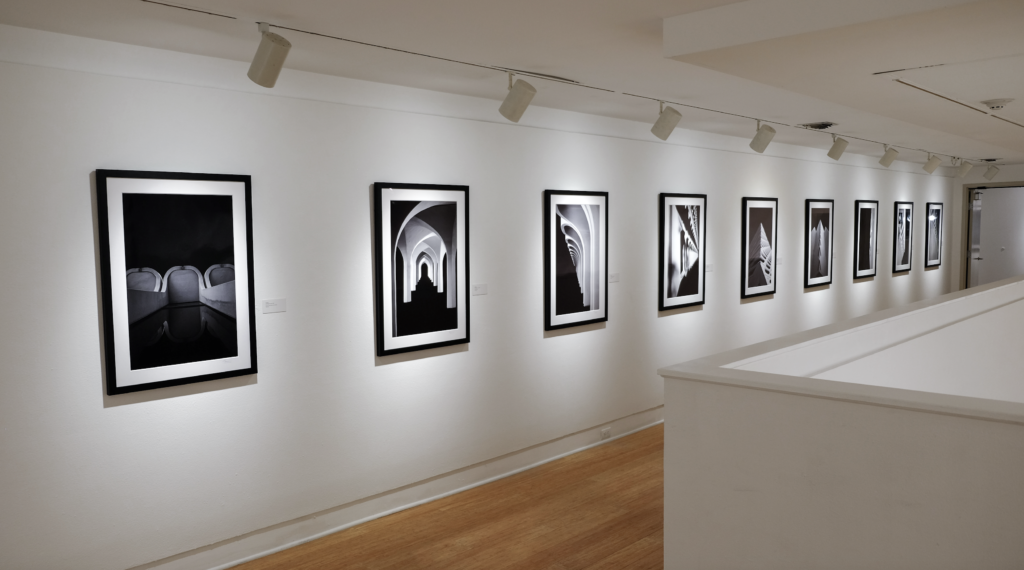
JG: “Where all this work started was my love of Abstract Expressionist painting and my inability to intellectually understand it. I was emotionally drawn, but I couldn’t put words to express why I was drawn that way. So, I started reading a lot about the Rothko’s and the Newman’s and people like that whose work really intrigued me.”
In the 1990s, Jacques was particularly moved by an exhibition of John McLaughlin’s work. Furthering his education on hard-edged abstract painting.

#26-1961

#13-1964

untitled (April) -1954
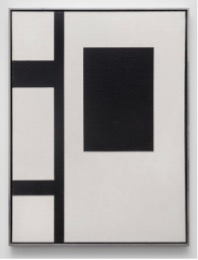
Untitled composition -1953
JG: “I saw a show of John McLaughlin’s work here at Laguna Art Museum in the 90’s, and I was just blown away by that show. So, that’s stored in the back of my mind, and then later I started looking at all that stuff again. So, a lot of this work was an attempt to create Abstract Expressionist feelings through photography. That’s what inspired this movement towards this kind of reductive work with a lot of negative space.”
In addition to their influence by Abstract Expressionist painting, Eastern Philosophy also plays a major part in both John McLaughlin’s and Jacques work. Jacques talked to me about Wabi Sabi and how that appreciation came to light particularly in his youth when he worked as a garbage collector.
JG: “Wabi Sabi, which originally was the philosophy behind the tea ceremonies in 16th Century Japan has been interpreted later as paying attention to things that have been discarded that most people don’t look at. I love repurposing things; taking something that has one use and then making another use out of it completely. That’s always fascinated me. I’ve lived in a world of discard for a long time. I put myself through university and Graduate School by being a garbage collector. I was looking at what was thrown away all the time. That led me to some very interesting environmental ideas, but that experience also elevated what was thrown away by making trash into something more meaningful in my mind. Taking trash and making it into art. How that translated into my art was basically looking at very small details. Details that normally we just walk by. I think that has also influenced this work in Hymns to The Silence. I’m taking larger details here, but that’s still what I’m doing. I’m not taking the whole building. I’m taking a part of the building and trying to focus on that part. Trying to recreate that part of what the architect did and make us see it again with fresher eyes.”
Jacques’ work forces us to notice surfaces, textures and all the subtleties and imperfections in the structures he photographs that would otherwise go unnoticed. Framed as they are in that absolute black, there is nowhere else to look but to all those beautiful imperfections. As author Richard Powell describes Wabi Sabi, I think Jacques would agree that “Wabi Sabi nurtures all that is authentic by acknowledging three simple realities: nothing lasts, nothing is finished, and nothing is perfect.”
We talked further about details and different ideas of repetition in Jacques’ work; repetition as a compositional element in his photographs. The beginning of this series started when Jacques photographed a medical building in Laguna Hills called the Taj Mahal. Anyone familiar with it will know that repetition in an integral feature to that building. A feature that Jacques was entranced by.
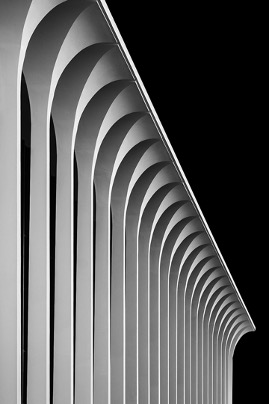
JG: “This is a building that I had driven by a whole bunch of times over the years and I thought someday I’m going to go out and shoot it. It just seemed interesting to me. It’s not a particularly pretty building, but the repetition intrigued me. So, I went and took this picture and then it sat in my computer for a while. I looked at it thinking ‘there’s something here’, but I hadn’t thought it through or developed it. And then one day I’m playing around with it and started eliminating everything but the detail of the building itself. I started playing around with negative space. So, I started to deconstruct, and then this idea of trying to create a series using buildings that had this incredible repetition might be an interesting thing to explore.”
As that exploration progressed, as his selective eye was deciding what eliminations are being made, one thing that needed to remain was the integrity of the building itself.
JG: “I did not want to eliminate the flaws, the broken chips, the little angles; all that stuff to me was really important and part of what the building is. I just wanted to isolate the building into a negative space so people would start paying attention and looking at the building.”
The working process for this series being set, the next step was finding more interesting buildings. Which is a process in itself.
JG: “How do I come about upon these buildings? So, I just do a lot of research at home looking at mid-century buildings in Los Angeles, or interesting architecture in Los Angeles. Then I’ll look at a list of buildings and addresses, and if I find a building that’s interesting, I’ll go to Google Earth. I’ll look at the building from the sky and from different angles to see if the building might be really good. Then I map out a location, say Santa Monica. Then I’ll find four or five buildings in Santa Monica that might be of interest, and then I’ll go shoot for three or four hours. And when I find a building that I think might be of interest, then I just slow down and walk around the building, and I try to be like a little kid who is seeing it for the first time. I just put aside my preconceptions, put aside my blinders, and try to feel something. To see if something, an angle or a view, resonates with me. That’s my M.O.”
As we spoke about an unusual work titled “Drifting Into Eternity”, we couldn’t help but speak about how being a non-traditionalist fits into Jacques’ work. Jacques and I both agree that you have to know the rules first before you can break them. Rules such as the Rule of Thirds and concepts like the Golden Ratio have served as important stepping stones of our educational journey. Its only because of the photographic knowledge Jacques has built upon over the last 20 years that he can make a work like “Drifting Into Eternity” and “Un monde à l’envers”

JG: “This is radical negative space. The blackness takes out 3/4 of the picture; this is not traditionally done in photography. But to me that’s how I saw this. I saw this really radical angle on a bland building, but when you float it like this in negative space with the real abstraction of the angles, I think it has some merit.”
Breaking the rules while we create new rules that better fit our working process; that’s one description of being a non-traditionalist. Leaving open the possibilities for new information is what any good artist should aim for. And leaving open possibilities for the viewer when confronted with an artwork is also important to Jacques. He talked to me about the idea of ambiguity in art.
JG: “I think ambiguity is really important in photography. The idea that things aren’t necessarily what they seem. That you have to question what it is you’re looking at, and that there’s a little bit of a mystery. That to me is part of what pulls you into the work of art.”
A piece like “Un monde à l’envers” is a very good example ambiguity. A piece that can suggest a hillside, where the black void has become an object. But it still retains Jacques’ attention to all those fine details a building can present.
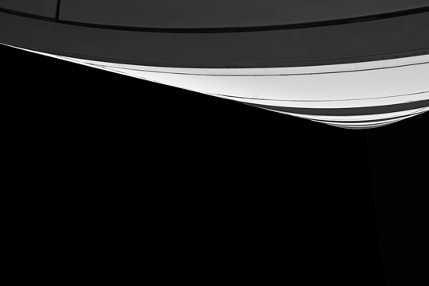
JG: “This is a marvelous example of what I’m trying to do with this show, because a lot of it is to try to get people to slow down and look at things. Most of the time we’re wearing blinders. We’re busy most of the time. You cross the street and 3/4 of the people crossing the street are looking at their cell phone. They’re not even looking to see if a car might run them over! We’re completely preoccupied, and we’re all guilty of it. But during this pandemic, it was a wonderful time to refocus, to meditate, and to slow down. We were forced to do all those things, and I guess part of my message is I’d like people to keep on doing that.”
Jacques reacts to his surroundings and to the knowledge he takes into his mind, leaving his mind open to interesting possibilities. What we connect to as artists, and the definitions that are discovered when making a body of work is seldom known at the beginning. Jacques will tell you that he doesn’t know what a series of photographs are going to be about when he presses the shutter. All he knows is his need for taking pictures and making art. That is what he’s reacting to. He and I both share that idea about art-making. Make the work; make it as satisfying to yourself as you can, and then extrapolate the meaning from the work thereafter. The external ideas that artists can arrive at to describe their work makes for a richer and satisfying art making experience, and contributes to a richer and more complex culture that surrounds us all.
Hymns to The Silence is up now at Laguna Art Museum through October 24th. Take the time to slow down, take your blinders off, and have an experience that will help you notice all the minute details you encounter during the day. You’ll walk away with an understanding of the beauty in the smallest and most over-looked, tiny pieces of life. The repetition of grooves in a sidewalk, the stucco on the side of a building, the broken texture of the asphalt in a street…none of it may look the same to you again.
-Joel Woodard holds a BFA in Drawing and Painting from Laguna College of Art and Design, class of 2004, and an MFA in Studio Art/Contemporary Practices from California State University, Long Beach, class of 2012. He teaches Art History online at Coastline Community College, and he also is the Director of Operations and Head of Security at Laguna Art Museum.



Robert Hansen
Posted at 09:04h, 18 AugustJacques,
Your comments about working in series of images has always been very important for my career in photography. One of my most effective classes when I was teaching photography workshops was my Portfolio Design Class. It was always the final class in a series of three and it was designed to give the opportunity for the students to create their own series of images choosing their own topic. They took the technical tools they were learning to give voice or a unique language to things they were interested in. Most of my students caught fire at that point.
Some series keep on evolving like my Mexican series even though I’m not traveling there anymore. Finding new ways to interpret images that were made 25 years ago with the new technology of digitally enlarged negatives and different printing papers always has brought life to an old series.
Your work is stunning Jacques. Major congrats!
Robert Hansen